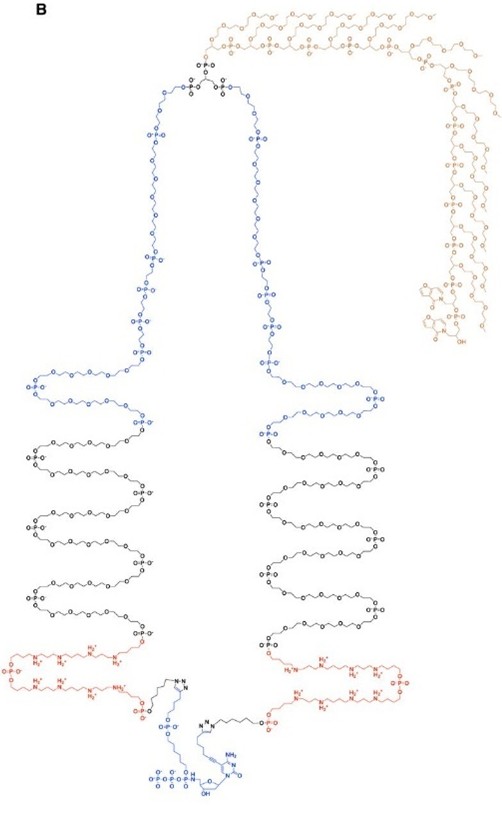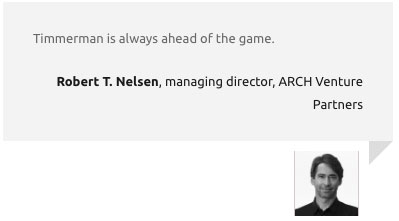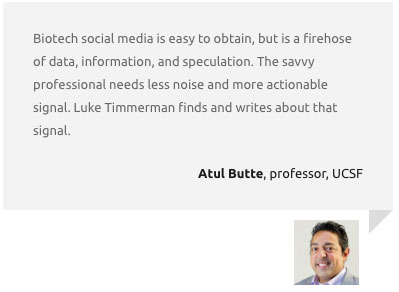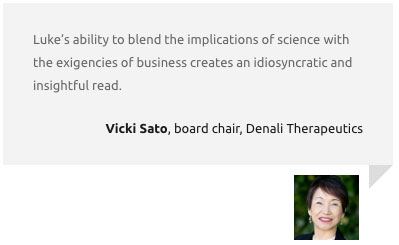How a Dark Horse Candidate is Upending the Sequencing Market

Joe Horsman, biotech investor, Madrona Venture Group
Before Roche officially announced their new sequencer in a pre-AGBT webinar in February 2025, only true sequencing aficionados had heard of Stratos Genomics or Sequencing by Expansion (SBX).
The SBX chemistry underlying Roche’s new sequencer was developed by Stratos Genomics, which Roche acquired in 2020 and paired with nanopore sensors from Genia Technologies, which Roche acquired way back in 2014.
Stratos Genomics has an unlikely origin story, starting from a skunkworks operation in Seattle-based Stratos Product Development. The now defunct Stratos Product Development worked on a range of technical products, including Microsoft Xbox controllers, Apple laptops, and Nike sunglasses.
In 2007, Stratos Genomics was born in a closet-sized lab based on a napkin sketch outlining the fundamental idea behind SBX: copying DNA into an expandable, surrogate molecule for easy nanopore sequencing. Over the intervening 18 years, a relatively unknown group of scientists and engineers painstakingly developed the chemistry that brought the initial SBX napkin sketch to life.
Stratos Genomics is perhaps one of the most unlikely candidates to develop technology that is now taking on sequencing giant Illumina. The leadership is devoid of ex-Illumina stars and academic luminaries. Group leaders inside Stratos (and now Roche) often lack long academic or industry accolades—or even PhDs—instead spending years working their way up from research associates inside the organization.
There was no mega-round from a brand name Silicon Valley VC to generate buzz. Very little capital went into the company at all. Stratos only raised around $60 million during its entire 15-year history prior to acquisition.

Mark Kokoris, former CEO, Stratos Genomics; VP and head of SBX Technology, Roche Diagnostics Seattle
The CEO, Mark Kokoris, likewise eschews the limelight—you won’t find him at many conferences or sitting on panels. Instead, he is laser-focused on building the next generation of sequencing in a Seattle office building converted into a lab. With this profile, it is not surprising that the sequencing world was taken by surprise when Roche announced an SBX-driven sequencer that seems poised to upend the status quo—they quite literally did not see it coming.
The sequencing world is buzzing about it now. Roche announced at the AGBT conference last month that the SBX technology reduces the time from sample to genome from days to hours—a potentially big leap in R&D productivity. It could also provide useful differentiation in the type of data it throws off as a “midi-read” instrument, positioned between the short-read (Illumina) and long-read (PacBio and Oxford Nanopore Technologies) players.
How it Works
SBX is a novel approach to nanopore sequencing, giving high accuracy short reads—almost a hybrid between Illumina-like SBS (sequencing by synthesis with short reads of DNA) and Oxford Nanopore which directly detect DNA and can give reads length of over 4 million bases.
With SBX, the DNA sequence is copied into a synthetic, surrogate molecule. A highly modified polymerase copies the DNA sequence, incorporating expandable nucleotides (XNTPs) instead of dNTPs, each of the 4 XNTPs contains a reporter molecule corresponding to its DNA base identity. After the DNA template is copied, the surrogate molecule is cleaved at the alpha phosphate, causing the molecule to expand 50X the length of the native DNA.
This “Xpandomer” is then sequenced through a nanopore. Because of the large sizes of the surrogate molecule only one base is read at a time, and the reporter molecule gives a clear, distinct signal for each base.
This was a heroic undertaking, requiring the combination of world-class chemistry, protein engineering, biochemistry and lots of determination. I saw some of this work firsthand, as I worked at the company from 2018-2022. For example, the polymerase evolution and engineering to specifically incorporate XNTP could barely begin until you had designed, generated and purified all 4 XNTPs! This could easily have been a cost and time prohibitive barrier to even starting.
So how did this dark horse bring this wild sequencing chemistry into the real world? Essentially, through one thing: grit. Long hours (11-hour days were completely normal), meticulous attention to every detail of the sequencing chemistry (Mark Kokoris will talk for days about chemical minutiae at every step of the process), and an unwavering belief that SBX could—and would—happen.
Over almost 20 years, SBX was willed into existence with (sometimes literal) blood, sweat, and tears.
But SBX is the type of scientific breakthrough that every scientist should be rooting for. When you hear about accurately copying DNA into a synthetic polymer 50 times the length of DNA—let alone see the chemical structures in the preprint (below)—every scientific bone in your body yells, “No way that works!” And yet, it works, and works really well, claiming a world record for DNA sequencing speed.
Look at this thing! Yikes

Expandable nucleotide structure. From Fig. 3, BioRxiv preprint. https://www.biorxiv.org/content/10.1101/2025.02.19.639056v2
Quick stats on where this sequencer lands:
- Blood sample to VCF (Variant Call Format) in under 7 hours
- 20 minutes of sequencing yielded a human genome (HG001) at 27X median coverage or >5 billion duplex reads in 1 hour of sequencing
- Accuracy sufficient for most workflow, 99.80% for SNVs, 99.48% for InDels
- Read lengths up to 1,200 base pairs (about double the longest Illumina reads)
- A sensor array with 8 million nanopores (almost 750X the number of pores Oxford Nanopore brings to bear)
However, big questions remain. Early access starts in 2025, but full commercialization won’t be until 2026, and there are still no hints on pricing. So, any predictions of disruption must come with an asterisk.
What Does This Mean for the Sequencing Market?
SBX brings two new (and underappreciated) axes to the sequencing discussion: flexibility and speed. These are tailor-made to solve pain points for clinical-facing customers.
With an instrument that offers flexible throughputs, large diagnostic providers no longer need to wait to fill up a sequencing lane—potentially bringing down clinical turnaround-times. SBX also uncouples read length from sequencing time, sequencing run times can be tailored to the amount of data needed. Obtaining 2X150 reads (300bp) on Illumina’s NovaSeq at the most cost-effective, high throughput can take up to 48 hours.
With Roche’s pedigree in diagnostics, Illumina is now being attacked on all sides. Element Biosciences is coming from the bottom up with a flexible sequencer accessible to many academic labs. Ultima Genomics is gunning straight at the mega-core, hyperscaler labs like the Broad Institute with an unquenchable thirst for raw read numbers, at below $100 per genome.
Even future growth markets like China are slipping away, with Illumina recently placed on an import ban list by the Chinese government, in favor of homegrown MGI. Now Roche steps into the fray, poised to take a shot at one of Illumina’s future bright spots, the clinical diagnostics market, with a full sample-to-answer offering and a large sales force capable of competing with Illumina around the world.
Illumina will be forced to respond. The big question is, “does Illumina still have enough scrappy, startup DNA left to fight, or will they retrench to service a dedicated install base?”
Illumina isn’t likely going anywhere. This dominant sequencing giant built the NGS market and ecosystem, embedding sticky workflows and customer relationships. The switching costs are high for these long-term customers. Illumina has a high-quality, well-known commodity, and a generation of scientists has been trained on its instruments. That will be hard to unseat. If you have an iPhone, and all your apps and data have been on it for years, what would it take to switch to an Android phone?
Entrenched as Illumina is, its growth prospects are very much in question. Illumina has been reducing its revenue forecasts as the entire biopharma industry grapples with a stagnant investment environment and now sweeping cuts to the NIH. New competitors in the sequencing field will make a return to growth much more challenging.
Illumina is also looking to break into adjacent fields like spatial biology, but these are far from green fields and incumbents won’t just roll over. Illumina’s new XLEAP sequencing chemistry is a nice, incremental improvement but perhaps a sign of a shift away from the ambitious, step-change innovations that drove the cost of sequencing from millions of dollars per genome to under $100.
For Roche, diagnostics will likely be the primary focus. There will certainly be research- and academic-focused instruments, but Roche’s greatest strength is its ability to offer a fully integrated solution for diagnostics. Roche has a checkered reputation in the academic sequencing world since discontinuing the 454 pyrosequencing platform in 2016. They will likely have to commit real resources to demonstrate SBX’s commitment to researchers. In contrast, Roche boasts a world-class molecular diagnostic sales force and end-to-end clinical solutions, positioning it to become the leader in clinical sequencing.
Roche’s SBX entrant poses an even bigger threat to Thermo Fisher Scientific and its Ion Torrent sequencer. While Ion Torrent doesn’t receive much attention, it has quietly built a strong business serving a largely clinical customer base. Roche poses an existential threat to Ion Torrent.
Among all the hype, what Is Roche’s weak spot? Expect to hear a lot about accuracy and Q scores from rivals as SBX’s launch date approaches. Single-read accuracy has been the Achilles’ heel of every single-molecule sequencing method. While Oxford Nanopore and PacBio have each developed solutions, Roche will face criticism that their raw read accuracy doesn’t measure up especially as PacBio’s Onso (the product of another sequencing acquisition—Omniome) and Element compete for ever-higher Q scores. Q50+, anyone?
What’s Next?
Will Roche’s big announcement spur further consolidation? Will large diagnostic players view a sequencer as a must-have, spurring Abbott, Thermo Fisher, Danaher, or Qiagen to buy one of the up-and-coming players? Singular Genomics was recently taken private by Deerfield—perhaps expect their sequencing box to quietly find a diagnostics-focused home.
Alternatively, will Illumina position itself as the “white knight,” the neutral platform for diagnostic companies to standardize on? Upwards of 50% of its revenue is likely clinical-focused, a space it can’t afford to concede to Roche. This is perhaps the most bullish opportunity for the beleaguered sequencing incumbent facing a seemingly never-ending stream of challenges.
Disclosure: the author was previously an employee of both Stratos Genomics and Roche.



